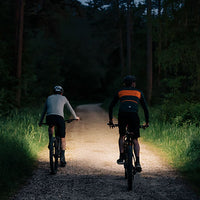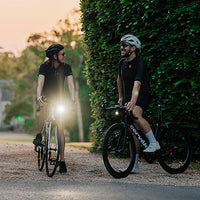Beginners Guide to Bikepacking!

Magicshine
Sep. 12 2024
Sep. 12 2024
When it comes to adventures, there's nothing like a bikepacking trip. The freedom to be able to go wherever you want, rain or shine, night or day, and on or off-road. It's an incredible way to see the world, and for many, it teaches the lesson that it's not about the destination but the journey.
When it comes to starting bikepacking, it can feel overwhelming, and you might need help understanding where to start. In this guide, we are going to be telling you everything you need to know about the right types of bikes, kit you need, and much more. We will discuss:
When it comes to starting bikepacking, it can feel overwhelming, and you might need help understanding where to start. In this guide, we are going to be telling you everything you need to know about the right types of bikes, kit you need, and much more. We will discuss:

What Bike for Bikepacking?
When it comes to bikepacking, the first thing you will need is a bike. Although any bike will do, the right bike will make the job much easier, and you are going to have a lot more fun on your bikepacking trip.


Terrain Correct
The first thing is to have a bike that is suitable for the terrain you are riding on. A road bike for tarmac and a mountain bike for trails. You could even go down the route of a gravel bike for a mix of both.The Right Qualities
Next, you need the bike to have the correct qualities for a bikepacking bike. Getting this right makes a huge difference to not just speed but also comfort. Here's what we recommend.Low Gearing
It would help if you had a bike that has the ability to go up hills easily with a wide range of gears. You will need it with all the extra weight and riding long days on tired legs.Comfortable Geometry
Next is comfortable geometry. This is the position you ride in. A racing bike will typically be aggressive, but on a bikepacking or endurance bike, it will be relaxing, taking pressure off the back and hands, keeping you on the bike all day.Durability And Reliability
The right bikepacking bike has to be durable and also reliable. This is so you can carry all the gear, take the rough roads, and also avoid nasty breakdowns that you are not able to fix. For road you can get away with less durability but when bikepacking gravel or trails it has to be right.Disc Brakes
Although not a necessity, disc brakes make a huge difference when it comes to bikepacking. They help you stop much faster despite the road and weather conditions, are better with heavier loads, and are much easier on the hands.Larger Tires
Larger tires make a big difference when bikepacking. Not only do they improve comfort, but they also help with grip, and they can really help when carrying extra weight. Larger tires really helps when it comes to bikepacking gravel.
What Bikepacking Gear Will I Need?
Surprisingly, when it comes to bikepacking, you need a fair amount of kit. In this article, we will give a basic rundown, but if you are looking for a more detailed blog, check out WHAT DO YOU NEED TO TAKE BIKEPACKING.


Tools And Spares
- Multi-Tool
- Pump
- Inner Tubes
- Patches
- Hanger
- Spare Spokes
- Spoke Key
Accessories
- Lighting
- Bikepacking Bags
- Navigation Unit Or Map
- Powerbank
- Charging Cables
- Head Torch
- Bell
Clothing
- Cycling Shorts
- Cycling Jersey
- Cycling Socks
- Cycling Shoes
- Helmet
- Rain Jacket
- Wind Jacket
- Arm And Leg Warmers
- Arm And Leg Warmers
- Gloves And Shoe Covers
- Down Jacket
- Any Casual Clothes
Sleeping
- Sleeping Bag
- Tent Or Bivvy
- Sleeping Mat
- Sleeping Bag Liner
- Inflatable Pillow
Personal
- Toothbrush
- Wipes
- Chamois Cream
- Medication If Required
- Passport
- Credit Card
- Cash

Training for an Adventure
A question we often get asked is, “How do I train for a bikepacking adventure?” Well, when it comes to training for a bikepacking adventure it can be done in a few different ways. Much of it comes down to how much time you have and what training you want to do. Here are our recommendations to ensure you're ready for a trip.
The more you can get used to riding loaded with all your gear, and being out in poor conditions helps too. The more challenges you can face when training, the better prepared you are going to be when the big adventure comes around.
Firstly, it builds the muscles in the legs not just for strength but also to help avoid injuries. Power can help you get up climbs much easier, and it also means you can pace much better, which is a big key when it comes to bikepacking.
Big Days Out
Having some big days out on the bike goes a long way to help you when it comes to bikepacking. Not only does it help you get used to the bike's position, but it is also good for building the base of endurance that you need.The more you can get used to riding loaded with all your gear, and being out in poor conditions helps too. The more challenges you can face when training, the better prepared you are going to be when the big adventure comes around.
Short Power Sessions
Just because you will be riding slowly and taking on long distances doesn't mean you need to avoid powerful short sessions. Doing high-intensity sessions not only grows your power as a cyclist but comes with many other benefits.Firstly, it builds the muscles in the legs not just for strength but also to help avoid injuries. Power can help you get up climbs much easier, and it also means you can pace much better, which is a big key when it comes to bikepacking.
Strength And Conditioning
Another great way to train for bikepacking is strength and conditioning training. This could be squats, lunges, deadlifts, or even push-ups. These exercises strengthen the body and protect you from injuries.
How to Staying Safe When Bikepacking?
A big part of bikepacking is staying safe. Being on the right roads and with the right gear isn't just about making the riding easy but also safer. When it comes to staying safe, here are what we recommend you do.


Great Lighting
There's no denying that great lighting is a must for any bikepacker. It needs to be powerful, have a long-lasting battery, and also be very reliable. At Magicshine, we have everything you need, and as lighting experts, we know the best lights for night bikepacking. The most important night riding tips for bikepacking include great lighting and ensuring you are always seen.
Ray 2600 And Ray 2600B
The Ray 2600 and 2600B is a 2600-lumen light with some excellent technology behind it. With a 14.5-hour runtime, wireless control, internal power bank, app customization, and dual light output, what's not to like? Definitely one of the best lights for night bikepacking.Ray 2100 And 1600
The Ray 2100 and 1600 are incredible lights to help you stay safe while on an adventure. A 27-hour runtime, smart sensor, and remote control make it easy to use and perfect for those bikepacking escapes.High-Vis Clothing
High-vis clothing is another way to stay safe and be seen by other road users. Bright colors and reflective elements make sure that you have the confidence to go into every day or night, knowing you are in everyone's view. Bikepacking night safety should never be overlooked.Good Route Planning
Planning a good route will keep you safe and give you a great experience. For the safest routes, we recommend applications such as Komoot and Ride With GPS. These are designed for cyclists and are good at keeping you off bad roads.
A Final Note
Bikepacking is an amazing way to enjoy riding a bike while seeing great parts of the world. To get it right takes time and experience. Everyone’s adventures are going to be very different, and the more you can do, the more you can open your mind.



0 comments